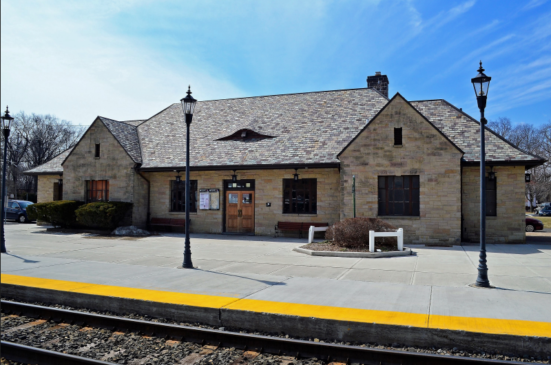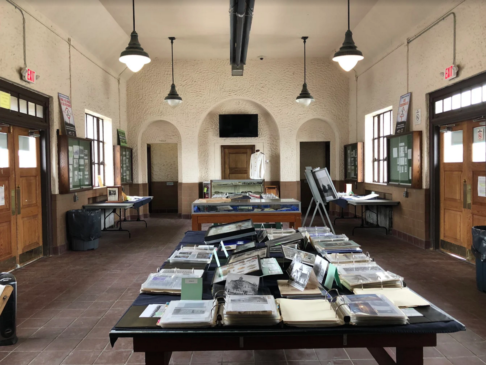
BY JOHN SNYDER
OF PASCACK PRESS
WESTWOOD, N.J.—The Westwood Train Station was just nominated to the State Register of Historic Places for its significance in the development of the borough as a 20th century commuter suburb and its distinctive architectural characteristics.
The project was spearheaded by the Westwood Historic Preservation Commission, which is chaired by Lauren Letizia—who singled out member David Hohmann and consultant Gregory Dietrich for their contributions since the start of the project.

This is the borough’s first nomination to the registers, and acceptance is expected. The Westwood Center Historic District earlier landed a State Historic Preservation opinion of eligibility for the National Register of Historic Places.
The station, at Broadway and Westwood Avenue, is a fixture on NJ Transit’s Pascack Valley Line, with trains running to and from Penn Station in New York with a transfer in Secaucus.
According to Letizia, the HPC regularly updates its inventory of historic sites within the borough. The list includes more than 115 properties deemed significant in their architectural style or historic significance.
Many of these properties are located in well preserved neighborhood pockets, such as those around Bogarts Pond in the Goodwin Park neighborhood, Terrace Drive, Westwood Avenue, and the Central Business District, and Jefferson Avenue (the only borough-designated Historic District).
Also included on the list are several railroad bridges and Old Hook Cemetery.
Emerson teeters on historic status
Just to the south, Letizia also worked on the team that this spring landed a state Historic Preservation Office Certification of Eligibility for Emerson Borough Hall to be listed in the New Jersey and National Registers of Historic Places.
As with Westwood, this would be Emerson’s first such addition to either register.
That nomination process is proceeding, haltingly, against an interesting backdrop—Emerson Borough Hall, dating to 1938-39 and housing priceless federal murals, does not meet Americans with Disabilities Act requirements for police departments, is undersized, and has been called “almost functionally obsolete.”
It’s subject to extensive renovation or demolition, and the administration said it wants voters to weigh in on what to do with the site without having it first secure historic status.
Spending options moving forward range from approximately $10 million to $15 million, an investment that will facilitate municipal operations into the 22nd century.
A nonbinding referendum anticipated for the November ballot was just postponed.
Historians on that project were its lead, Jill McGuire, with Linda Flynn, Dwight De Stefan, and Letizia, who succeeded where a 2001 push for historic status for Borough Hall did not.

Train Station makes the grade
Research support for Westwood’s Train Station was provided by the Westwood Heritage Society, which keeps its archives in the station’s former ticket and baggage rooms.
Completed in 1932, the station was eligible under Criterion C (architecture) for embodying the distinctive characteristics of an early 20th-century suburban train station designed in late Tudor Revival style—note the eyebrow window over the entrance.
The building was also eligible under Criterion A (event) for its contribution to Westwood’s development as a 20th-century commuter railroad suburb.
Letizia told Pascack Press that Mayor John Birkner Jr. and the Borough Council threw their eager support to the endeavor, which now secures the station and surrounding parkland—once called Station Plaza and now making up the eastern portion of Veterans Memorial Park—as a historic site worth of preservation.
“The park is noted to be an ever-changing hub of civic activity and the nomination makes that clear so that popular programs, including the Memorial Bench Program, which Peter Grefrath so diligently worked to create during his tenure as councilman, can continue to thrive,” Letizia said.
She added that any changes undertaken by the borough or another government entity will be subject to state review “so that damage does not befall the historic site.”
This stipulation is unique to government-owned properties on the State Register, she said; private property owners would not be subject to such restrictions.
“As this land is held in the public trust, listing on the state register ensures that it be dutifully protected for future generations of residents and visitors to our thriving community,” Letizia said.
She added that, because it will be listed on the state register after unanimous support from the State Historic Preservation Review Board, after some minor revisions to the text of the application, the station is eligible for listing on the national register.
The State Office of Historic Preservation will submit the nomination to Washington, D.C. on Westwood’s behalf within the next few months, she said.
“This is an exciting time for Westwood and speaks directly to the pride of our residents,” she added.
The station is particularly appealing for the ways in which it served as the gateway between the formal commercial center of Westwood to the east and the informal village green to the west of the tracks.
Its vernacular detailing and materials, such as the multi-colored stone walls and a slate roof, were unique to Westwood which, at the time, was composed of wood-frame or brick and stucco buildings.
Letizia said the building is prominent through its symmetrical, geometric plan and inviting by its detailing—including the flared hipped roof and eyebrow window over the central doors.
By the time the station opened, the borough had become a regional shopping destination with more than 150 stores and a steadily rising population.
Appeal to property owners
Property owners are encouraged to check out the HPC webpage on the borough website to see if their property is part of the inventory and learn more about the benefits of listing on the State and National Registers.
“We are always eager to know what sites matter to our residents and work with them on nominations and designations,” Letizia said.
The HPC meets at 7:30 p.m. in Borough Hall on the second Wednesday of each month.
— This story benefitted greatly from background supplied by Lauren Letizia
